Event – A Visit to the Home of Panamax
| Event – A Visit to the Home of Panamax |
| Reprinted with permission |
| Steve Ekblad |
| 21 October 1999 |
At one time or another, everyone suffers equipment failure due to a power surge, spike, or lightning. Most of these failures are assumed to be problems associated with the devices in the equipment rather than a problem with the supply line, telephone line, satellite feed, cable, or antenna feed. In reality, many of these failures can be attributed to just the sort of electrical beasts that can travel in and raise havoc with our products.
One of the best products to provide a barrier to these uninvited guests comes from a company known as Panamax. They are known worldwide as the very best in protection. They also put their money where their mouth is my backing up their guarantee with an equipment replacement if their device fails to stop the electrical demons. I recently had the opportunity to visit the Panamax factory. They graciously allowed me to tour their facility and share my visit with you. I hope you will enjoy this visit as much as I did mine!
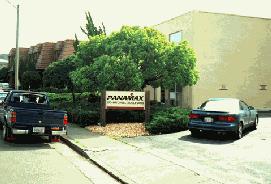 The very first thing on my tour was to meet some of the support staff at Panamax. From the minute you arrive, you can tell that there is a Panamax family! Everyone is in tune with their specific tasks and is part of a team. The Panamax customer support team handles a large volume of customer calls. This kind of call traffic requires a highly skilled team of trained staff who are capable of handling any problem that might come their way. I watched them handle everything from basic product inquiries to answering a rather complex technical question. Each was handled with care using a state of the art support database as reference documentation. For visual aid, users who had access to the web as well as a telephone, were directed to their excellentweb site where technical support documents, FAQ’s, diagrams, and illustrations ease the understanding of how to correctly use their protection products.
The very first thing on my tour was to meet some of the support staff at Panamax. From the minute you arrive, you can tell that there is a Panamax family! Everyone is in tune with their specific tasks and is part of a team. The Panamax customer support team handles a large volume of customer calls. This kind of call traffic requires a highly skilled team of trained staff who are capable of handling any problem that might come their way. I watched them handle everything from basic product inquiries to answering a rather complex technical question. Each was handled with care using a state of the art support database as reference documentation. For visual aid, users who had access to the web as well as a telephone, were directed to their excellentweb site where technical support documents, FAQ’s, diagrams, and illustrations ease the understanding of how to correctly use their protection products.
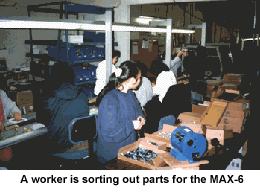 From there I was on to the assembly plants. Panamax has been growing at a rapid pace and has burst from their building space many times. They now overflow into 6 facilities in the same industrial park. Each area has been maximized for its specific function. I started with the incoming parts area. Panamax provides a very high level of quality control and it begins with the vendors they choose to provide their raw parts. Each must conform to their rigid requirements for 100% quality control and a goal of zero defectives!
From there I was on to the assembly plants. Panamax has been growing at a rapid pace and has burst from their building space many times. They now overflow into 6 facilities in the same industrial park. Each area has been maximized for its specific function. I started with the incoming parts area. Panamax provides a very high level of quality control and it begins with the vendors they choose to provide their raw parts. Each must conform to their rigid requirements for 100% quality control and a goal of zero defectives!
After admiring the bins of parts to be combined into product we began a tour of a line dedicated on this day to building the very popular MAX-6 from their product array.
This unit is built by hand with the aid of careful preparation of parts and design. The components are added to the circuit boards using hand insertion. Each component is supplied already trimmed to the exact needs of the product design.
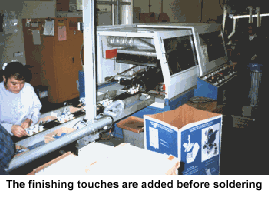 Then they are placed onto a conveyor system that will provide the solder connections for the basic protector parts. This process is very well thought out. I was impressed to find that they even considered the rise in temperature of the circuit board in their wave soldering machine and had further customized a very high quality machine into one that assured the highest consistency for their solder joints while preserving the integrity of the circuit traces. One modification to this machine resulted in the ability to precisely support the circuit board while minimizing the wear and tear on the track that handles the boards themselves.
Then they are placed onto a conveyor system that will provide the solder connections for the basic protector parts. This process is very well thought out. I was impressed to find that they even considered the rise in temperature of the circuit board in their wave soldering machine and had further customized a very high quality machine into one that assured the highest consistency for their solder joints while preserving the integrity of the circuit traces. One modification to this machine resulted in the ability to precisely support the circuit board while minimizing the wear and tear on the track that handles the boards themselves.
The next stop is a touch-up station that removes a pair of solder masks that protect the future location of the line cord connections. At this station, they are able to repair any poor solder joints. With the precision of their solder machine and the proper component and board preparation, this task rarely needs to be performed. To assure air safety, they have a high quality air exhaust system through out the line.
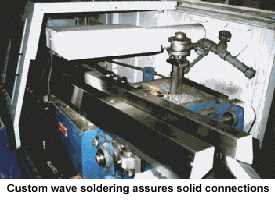 Next a pair of eyelets is pressed into the circuit board and the power cord is attached. The entire assembly is installed into an outer chassis half and the final components are connected and installed. The top cover is screwed on and the finished assembly is prepared for its visit to quality control.
Next a pair of eyelets is pressed into the circuit board and the power cord is attached. The entire assembly is installed into an outer chassis half and the final components are connected and installed. The top cover is screwed on and the finished assembly is prepared for its visit to quality control.
At the quality control stop, the Panamax protectors are subjected to a full battery of tests. Each must pass with flying colors or it is rejected. From the looks of the size of the stack of passed units compared to the small plastic bin with a single MAX-6 that didn’t pass the tests, I would say this is indicative of the quality of product I want to own!
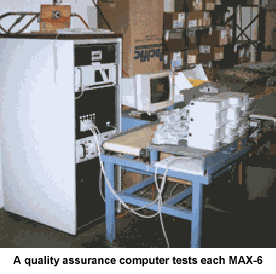 From quality control, the finished product goes to a product printing station where the logo and feature identification is added. They use a system that precisely prints using a stamping system. This process is all done in-house and their own team creates the product look and identity with a style that is immediately recognizable as their own. After the printing process, a special packaging machine boxes the units with their respective instruction manuals and warranty information.
From quality control, the finished product goes to a product printing station where the logo and feature identification is added. They use a system that precisely prints using a stamping system. This process is all done in-house and their own team creates the product look and identity with a style that is immediately recognizable as their own. After the printing process, a special packaging machine boxes the units with their respective instruction manuals and warranty information.
From this station, the finished product is boxed into cases and palletized. The product is then stored and in fairly short order shipped to their dealers. I also visited the assembly lines for other products including two of my favorites, the MAX-1000 and the MAX-1500. These products are built within a rigid metal chassis and have a more complex assembly because of their added features that make them the choice of enthusiasts of audio and video enthusiasts throughout the world.

Each device is packaged, labeled and packed into master cartons to be shipped directly to their dealers and distributors.
Just a glance inside shows the quality that Panamax builds into these units.
![]()
Don’t forget to bookmark us! (CTRL-D)
Stereo Times Masthead
Publisher/Founder
Clement Perry
Editor
Dave Thomas
Senior Editors
Frank Alles, Mike Girardi, Russell Lichter, Terry London, Moreno Mitchell, Paul Szabady, Bill Wells, Mike Wright, and Stephen Yan,
Current Contributors
David Abramson, Tim Barrall, Dave Allison, Ron Cook, Lewis Dardick, John Hoffman, Dan Secula, Don Shaulis, Greg Simmons, Eric Teh, Greg Voth, Richard Willie, Ed Van Winkle, Rob Dockery, Richard Doron, and Daveed Turek
Site Management Clement Perry
Ad Designer: Martin Perry





Be the first to comment on: Event – A Visit to the Home of Panamax